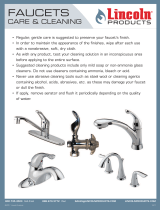
Deep Cl_a[i
sanit_w
Heavy D£y
Noma}
Hand Wash
Sl_i_ On@
]%mpe[@tu_e Spin Sl_eed
This manual covers many models and not all cycles, options, or features listed are available on
every model. Console shown above for reference only. Your model may differ.
Cycle Selection
Turn the cycle selector in either direction to the cycle desired.
For best results
Follow the fabric care label
instructions on items to be
washed.
Tochange the cycle once it has begun, press the Cancel
button before selecting a new cycle. Just turning the cycle
selector knob to another selection will not change the cycle.
If the selection is changed after the cycle starts, the indicator
lights will blink, the signal will beep and "Err" will be
displayed. The signal will beep and the status lights will flash,
but the original cycle will continue.
Deep Clean Sanitary
Use this cycle to clean heavily soiled, colorfast fabrics in-
cluding towels, bedding, children's clothing or other items
where sanitization isdesired. This cycle combines super hot
water temperature and fast speed tumbling to help ensure
the removal of heavy soils and stains. It isrecommended
that you set your hot water heater to 120F (49C) to ensure
proper performance during the cycle. If the setting islower,
the cycle time will be extended by 30 minutes or more.
The Deep Clean Sanitary cycle will kill 99.9% of bacteria
with no carryover of bacteria between loads. No bleach or
harsh chemicals are required, but higher temperatures are
required. Pleasecheck fabric care labels to prevent damage.
Only the Sanitize temperature setting isavailable.
This cycle hasbeen certified by NSFInternational, an
independent third party testing and certification organization
dedicated to public health, safety and environmental protection.
NSF Protolcol P172
Sanitization Performance of Residential
and Commercial, Family-Sized Clothes
Washers
The wash water is heated by an internal boost heater to
a maximum of 152° Fasthe load tumbles for up to 90
minutes. "SF_n" is displayed during the wash phase alter-
nately with the estimated cycle time. Cold water is added
to cool down the load prior to drain and spin.
::_,_If the voltage at your outlet is under 110 v, the
internal heater may not adequately heat the wash water. If
the cycle is interrupted while the water is heating, the final
temperature of the wash water may be lower and sanitation
may be reduced.
As a precaution, the washer door is locked once the water
temperature reaches 130° E If the cycle is cancelled during
the wash phase and if the water temperature is greater
than 150° F,an automatic cool down and drain will occur
before the door can be opened. "_d" will be displayed.
Heavy Duty
TheHeavy Duty cycle provides 20 minutes of reversing
tumble wash action for heavilysoiled sturdy items. Hot water
is recommended to remove heavy soil and most stains. Stain
Clean, Extra Rinse and Extended Spin are available options.
Normal
The Normal cycle provides 15 minutes of reversing tumble
wash action for normally soiled loads. Stain Clean, Extra
Rinse and Extended Spin are available options.
Perm Press
Perm Press Cycle provides 10 minutes of reversing tumble
wash action for cottons and blends with a no-iron finish. To
minimize wrinkling, the Warm Rinse and Extended Spin
are not available with this cycle. The Stain Clean and Extra
Rinse options can be selected.
Delicates
This cycle provides 10 minutes of gentle reversing wash ac-
tion for knits and delicates. To protect your delicate items,
a hot water wash, Heavy Soil, and the Extended Spin
option are not available. The Stain Clean and Extra Rinse
options are available.
Hand Wash
Select the Hand Wash cycle for items labeled "Hand Wash-
able". Tenminutes of occasional tumbling are followed by
2 rinsesand a slow final spin. Toprotect your hand wash-
ables, a hot water wash, Heavy Soil, the Stain Clean and
Extended Spin options are not available. The Extra Rinse
option is available.
Washing wool garments labeled "Dry Clean Only"
or using chlorine bleach can result in permanent damage.
Spin Only
Usethe Spin Only cycleasa follow-up to a No Spin selection
or anytime you want to drain water from the washer and spin
out the load. Selectthe spin speedappropriate to the load. To
add a rinseprior to spin, selectthe Extra Rinse option.




















